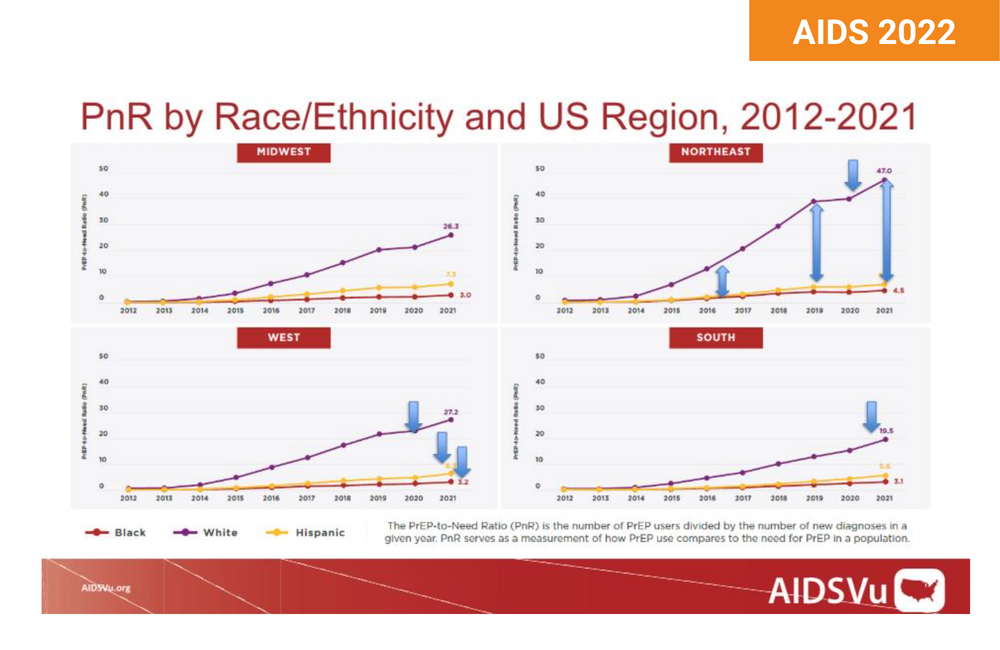
HIV pre-exposure prophylaxis (PrEP) inequities in the US – both in terms of race and geographical location – have not only persisted in the last decade, but have increased, according to research presented to the 24th International AIDS Conference (AIDS 2022) by Dr Patrick Sullivan from Emory University.
While PrEP pills have been approved for use in the US since 2012 – and PrEP injections were approved late last year – there have been challenges scaling up access, especially for groups who have disproportionately high rates of new HIV diagnoses, such as Black and Hispanic men who have sex with men and people living in the South of the US. Previous research has shown that medical professionals in the US are less likely to prescribe PrEP to Black and Hispanic clients, contributing to the stark racial and geographic disparities.
“Health equity dictates that access and use of prevention interventions should be proportional to the impact of the health concern in the population,” Sullivan emphasised.
The study
To investigate who was accessing PrEP in relation to who needs it most, Sullivan and colleagues used commercial pharmacy data to count PrEP users by US Census region from 2012 to 2021. Race and ethnicity data were available for 124,835 PrEP users (34%) in 2021. The researchers assumed that the racial distribution was the same in PrEP users with missing data as those who had provided this information.
In order to determine if PrEP access was equitable, the researchers calculated a PrEP-to-Need Ratio (PnR), which is the number of PrEP users divided by the number of new diagnoses in that group in the same year. For 2020 and 2021, the number of new diagnoses used was the 2019 number, the most recent year with available data.
Findings
The PrEP-to-Need Ratio revealed PrEP inequities by both race and region that have worsened over time, as seen in the panel of different graphs. The different coloured lines show the PrEP prescriptions filled by different race and ethnicity groups, with the purple line representing White individuals, the yellow line Hispanic individuals, and the red line, Black individuals. In all regions over the last decade, the PnR for White people increased much faster than for other racial or ethnic groups, indicating an inequitable gap in PrEP uptake.
In regions such as the Northeast, there was a particularly large gap indicating that those accessing PrEP most frequently and those needing it are not the same. For instance, 47 White individuals were taking PrEP for every new HIV diagnosis among White people in this region compared to only 4.5 Black people on PrEP for every new diagnosis. In regions such as the South, the PnR for all groups is lower than in other regions, indicating regional inequity across racial and ethnic groups.
PrEP equity was clearly stratified by race, with White people accessing PrEP most frequently, followed by Hispanic individuals and with Black people accessing it least frequently. Sullivan pointed out that equity would mean that all the lines would sit on top of each other, as opposed to diverging so dramatically.
Sullivan made it clear that the PnR is solely an equity metric. Thus, there is no specific target level or ideal PnR, and the analysis does not address the levels of PrEP that would be needed to achieve targets to reduce the number of new HIV diagnoses. One limitation is that there was a substantial amount of missing race and ethnicity data, but this did not differ substantially by region.
Conclusion
“Prevention programmes should be guided by PrEP equity and not PrEP equality, which focuses on equal use in different groups, regardless of the proportion of HIV diagnoses in that group,” Sullivan concluded. “By this measure, US prevention programs in all regions demonstrated decreasing PrEP equity over time. The US South lagged behind all regions in equitable PrEP use, with the lowest PnR overall compared to other regions.
"Better programmes are needed to provide PrEP to communities and people at greatest risk of infection. PrEP use tends to be more equitable in states that have PrEP Drug Assistance Programmes, Medicaid expansion, or both.”
Sullivan P et al. Trends in PrEP Inequity by Race and Census Region, United States, 2012-2021. 24th International AIDS Conference (AIDS 2022), Montreal, oral abstract session OALBX01, 2022.
View the abstract on the conference website.
Interactive data visualisations of PrEP use in the US can be viewed on AIDSVu.
